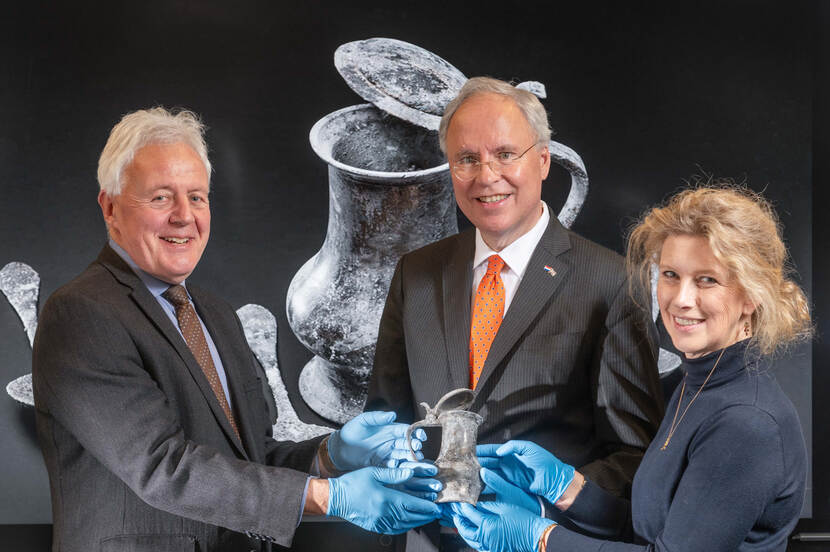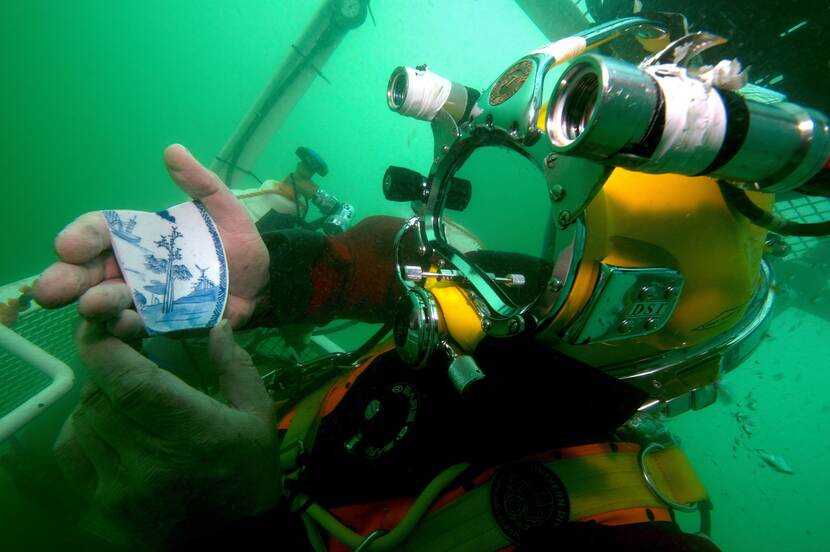Rooswijk artefacts return to the Netherlands
In November 2023, 2560 objects of the Dutch East India Company’s shipwreck Rooswijk will be returned to The Netherlands. The artefacts include inventory, cargo, silver coins and personal items, which will be stored at the National Maritime Depot at Batavialand in Lelystad, The Netherlands.
This transfer is part of the excavation project carried out by the project partners Cultural Heritage Agency of The Netherlands (RCE), Historic England (HE) and UK contractor MSDS Marine. The #Rooswijk1740-project started in 2016 when it was determined that the wreck, which is located at a depth of 25 meters on the Goodwin Sands, Kent (UK), is at high risk. The return of the objects is significant for The Netherlands, since it will enable the RCE and partners to show them to the public to tell the story of this particular part of our shared maritime history.
In the presence of project members, Duncan Wilson, CEO of Historic England, handed over several objects from the Rooswijk to ambassador Karel van Oosterom on 10 November. Next week, the objects will be packed and shipped to the Netherlands.
[The text continues below the photo]

Shipwreck
On the 10th of January 1740, the Rooswijk was en-route to Batavia (modern-day Jakarta, Indonesia) when it was caught in a storm on the Goodwin Sands (UK). All 237 crew members and cargo perished. An archaeological assessment of the site in 2016, undertaken by the RCE (on behalf of the Ministry of Education, Science and Culture) and HE (on behalf of the Department of Digital, Culture, Media and Sport), showed that the wreck site is at high risk. As a result, a two-year excavation project began in 2017, in collaboration with contractor MSDS Marine. In total, 2500+ objects were recovered, including equipment, silver coins, sabres, personal items of the crew, ship timbers, and other items. These were transported to HE's research facility in Fort Cumberland, Portsmouth, where specialists started the process of analysis and conservation.
[The text continues below the photo]

Joint investigation
Over the past seven years, HE, the RCE and partners have studied the items found at the wreck site, identifying materials and analysis of their composition, stabilisation and conservation of artefacts, and dendrochronological research into timber. The #Rooswijk1740-project also enabled the partners to develop new digital tools to enable non-divers to visit the wreck as well, such as 3D photogrammetry and the virtual dive trail.
The Netherlands and the UK are both long-time maritime nations. Their heritage reflects on this past. By cooperating, RCE and HE not only protect their own but also each other’s heritage and by doing so, set an example for international cooperation. “It is through cooperation such as executed on the #Rooswijk1740 project that we learn more about ourselves and our relation with other countries” explains Martijn Manders (RCE). “By exchanging perspectives we learn the most, and this is how we can also broaden our own perspective of that same past. We have learned an awful lot about the VOC, the lives of people in the 18th century and life on board in particular. The objects from the Rooswijk for example will be used to make this information, the stories we have identified, come alive. Without responsible management, these wrecks and the opportunity to learn more about our past, will disappear”.
Duncan Wilson, CEO of Historic England, adds: “International collaboration, like this partnership with the Cultural Heritage Agency of the Netherlands, is so important for preserving our shared maritime heritage. This seven-year project has revealed fascinating new facts about the 18th-century Rooswijk and will see the artefacts we recovered saved for future generations to enjoy.”
Looking forward
Mid November, most of the artefacts will arrive at the National Maritime Depot at Batavialand in Lelystad, the Netherlands. The remaining finds will stay in Portsmouth, UK for a while longer, since the conservation process of those items is not yet finished. The Rooswijk objects will be stored in the National Maritime Depository in Lelystad and made available in the future for loans for exhibitions.